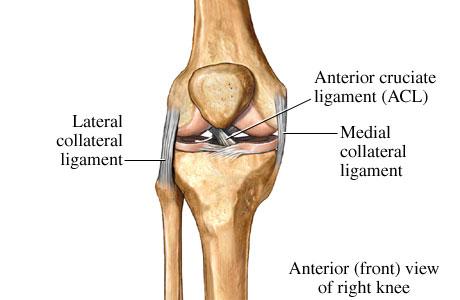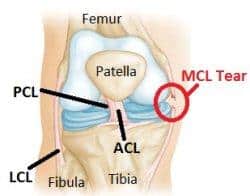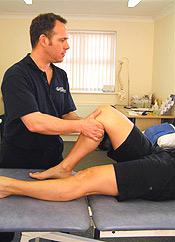Medial Collateral Ligament (MCL) injury is sprain or tear of the MCL. This ligament is a band of tissue that connects the femur (thighbone) to the lower leg (tibia) on the inside of the knee. The primary function of the MCL is to prevent the knee from bending inwards, also known as a valgus force. The ligament also helps increase the stability of the knee joint.
Medial Collateral Ligament (MCL)

What is Medial Collateral Ligament(MCL)?

What Causes It?
There are different ways through which the MCL can get injured. The most common ways are through the twisting of the knee while the leg is anchored to the ground, wrong landing from a jump or a direct force from the outside of the knee. This mainly occurs during sports when the opponent hits the knee from the outside.
Symptoms
The MCL injuries fall under three grades: Grade I (mild), grade II (moderate) and grade III (severe) injuries. The symptoms of an MCL injury depends on the level of the injury. The grade I and II injuries usually have some symptoms of pain and swelling while grade III injuries experience more difficulty with knee instability and functional activities. Symptoms include:
- Knee Swelling, Especially Around The Inner Part Of The Knee
- Pain In The Inner Part Of The Knee
- Knee Instability
- Difficulty Walking
Diagnosis
The Physiotherapist can often diagnose a knee injury via a thorough physical examination. The physical examination involves feeling, moving and measuring structures around the knee to determine the injured structures. During the examination, the patient may feel tenderness and some pain in the knee. One of the special tests used to diagnose this injury is the valgus stress test. Below is a Youtube video that demonstrates this test.
Your doctor or physiotherapist may recommend you get further imaging done such as an X-ray scan or an MRI to confirm the diagnosis of an MCL injury. The X-ray shows the condition of the bones in the affected area while the MRI scan shows the soft tissue structures in the knee such as the ligaments.

Treatment
The treatment of the MCL injury usually depends on the severity of the injury. For mild ligament injuries, treatment may include:
- Applying ice to the knee.
- Splinting/ knee brace.
- Limiting physical activity that may strain the knee until the swelling and pain have reduced.
- Specific exercises that help regain the knee range of motion and strengthen the surrounding muscles.
For more severe MCL injuries, such as a grade III rupture, surgery may be considered to repair or reconstruct the ligament.
Tips And Tricks For Managing Daily Activities
- Strictly follow the instructions from your physiotherapist for a quick recovery, especially regarding rest from play.
- Avoid putting too much strain on the recovering leg in the initial stages.
- Continue your exercises as prescribed by your therapist!
Prevention
You can reduce your risk of having an MCL injury in the following ways:
- Following sports safety guidelines for adults and children.
- Regular stretching.
- Strengthening the leg muscles that help stabilise the knee joint.
Getting Better
It is important to remember that recovery depends on many factors including the extent of the injury and whether it is managed conservatively or surgically. However, generally:
- A grade I and II MCL injury can take 3-6 weeks for full recovery.
- A grade III injury may take 3-4 months to recover fully.

Take Home Message
Following your physiotherapist’s instruction is vital to a timely recovery of an MCL injury.

New Client Offer - 10% OFF
Are you in pain? Not sure if we can help you?
Book your initial appointment and receive 10% off any service!